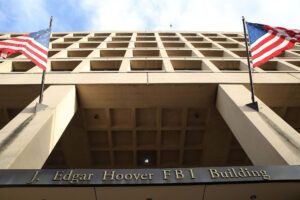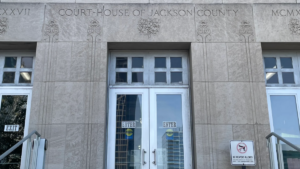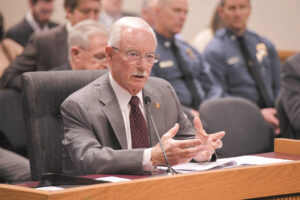11:35
News Story
State control of Kansas City’s police has roots in the Civil War
Supporters of state control say the system was established to limit Tom Pendergast’s influence in the 1930s. But the 150-year history of state control dates back to the Civil War
This story was originally published by the Kansas City Beacon.
Kansas City is the only major city that lacks control over its own police department. The oft-stated rationale for state control is to prevent local partisan politics from interfering with the workings of the department. Champions of the unusual setup often cite the political corruption under the Pendergast political machine in the 1930s as a rationale.
But the system of state control has not made the Kansas City Police Department (KCPD) immune to controversies — political or otherwise.
From a highly criticized police chief hiring process earlier this month, to complaints from Mayor Quinton Lucas regarding fiscal responsibility, a U.S. Department of Justice investigation into allegedly racist hiring practices and perennial brutality lawsuits, many Kansas City advocates, politicians and voters have been outspoken about the department’s lack of accountability.
And although the police department’s official history webpage points to the Pendergast corruption in the early 1900s as the origin of the state-controlled system, the more-than-150-year history of the governor-appointed Board of Police Commissioners tells a more complicated story.
‘A war measure’
Up until 2012, police departments in both Kansas City and St. Louis were governed by state-appointed police boards. St. Louis gained local control of its police department after a 2012 statewide referendum. Kansas City, under Mayor Sly James at the time, opted not to join in the ballot measure.
State control of Missouri’s two largest police forces began in the latter half of the 1800s and was rooted in pro-slavery Civil War machinations.
The Kansas City Police Department was established in 1874. St. Louis Metropolitan Police Department was created on the eve of the Civil War.
At the time, Missouri was contemplating whether it would secede from the Union with the other border states. Then-Gov. Claiborne Fox Jackson was in favor of joining the Confederacy, and he established the state-controlled police system in anticipation of the upcoming war.
He appointed four secessionists to the St. Louis police board in March 1861, including Basil W. Duke, who was a commander in a white supremacist militia called the Minutemen. Duke would later become a Confederate general.
Two months later, Jackson’s secessionist plan was put in motion.
Jackson had conspired with Duke and the Confederate President Jefferson Davis to take control of the weapons stored in the St. Louis Arsenal, which was the largest arsenal in the slave states, in order to distribute them to the Confederate army. This event is known as the Camp Jackson affair. They were ultimately unsuccessful after the militia was captured by the U.S. military.
“The police bill was in reality a war measure, adopted to enable our people to control St. Louis,” Duke later said, as reported in Lion of the Valley by James Neal Primm. “I knew the meaning of the measure … and tried to carry it into action.”
The failure of the Camp Jackson affair is credited as the reason Missouri never officially joined the Confederacy.
Kansas City’s police bill
In the aftermath of the Civil War, the Missouri legislature passed a bill to take control of KCPD. The bill was supported by Democrats, who sought to limit civil rights gains during the Reconstruction era. Opponents included representatives from St. Louis, a Radical Republican abolitionist from northern Missouri, and several other Republicans from across the state, including one from Jackson County.
Police departments at this time across the country were often established to control freed slaves and prevent unionization efforts among workers.
In the decades following the Civil War, the Black population in Kansas City had grown exponentially, from only 190 people in 1860 to 8,100 in 1880. This growth could have played a role in the state’s decision to remove the police department from city voters’ control, as Democrats at the time were attempting to limit Black voters’ power at the ballot box, including in Missouri.
Kansas City Republicans expressed strong opposition to the bill when it was proposed.
At a Republican convention, the Kansas City Daily Journal of Commerce reported at the time, “denunciations of the law was scathing and forcible and was enthusiastically applauded.”
“It is a step toward the old tyranny that led to the disruption of the colonies and the mother country a hundred years ago,” said Benjamin McLean, a speaker at the convention.
The editorial board of the Daily Journal of Commerce vehemently opposed the police bill. The Kansas City Times was in support.
The bill would ultimately pass. Once created, the Kansas City Board of Police Commissioners appointed its first chief of police, Thomas Speers.
Political corruption
One of the first conflicts between city leadership and the state-controlled police board arose at the end of the 19th century, when Gov. Bill Stone engineered the ouster of Speers, who by then had served for 21 years and was beloved by city leaders.
When the police board initially refused to fire Speers in line with Stone’s wishes, Stone removed the board members and replaced them with commissioners who would comply.
The reason, Stone had alleged, was because he said Speers was ineffective at preventing crime. This was loudly refuted at the time by city leaders.
After Speers was removed, his replacement L.E. Irwin fired 16 police officers, all of whom were Republicans. The department cited a lack of available funding.
This ignited an intense argument during a police board meeting where then-Mayor James Jones accused the police commissioners of turning the police department into a “political machine.”
“Mayor Jones brought his fist down upon the table with such force that all of the reporters jumped,” a Kansas City Star reporter wrote at the time. “‘I charge,’ he said, ‘that it is not your purpose to keep down expenses but to remove Republicans from the force.’”
During the heated debate, Jones told a police commissioner, “If I lived to be as old as you are and didn’t know any more I’d think I was a failure.”
Following the firing of Speers, The Star wrote that illegal gambling began to operate more openly in Kansas City, with the full knowledge of the police force.
Local control in the 1930s
State control of the police department continued until 1932, when a court challenge placed the department in the hands of the city government.
The court’s reasoning was similar to a central argument for local control being made today: “It is unconstitutional to give any one municipal body the power of unlimited spending of funds the responsibility of raising which rests upon another body.”
In the decades leading up to this court decision, Kansas City boss Tom Pendergast had already been building political power through bribery and voter fraud.
Once the court granted local control, then-City Manager and Pendergast ally Henry McElroy placed the department under his direct supervision, allowing Pendergast influence over the police department.
By 1939, police-controlled elections were beginning to infiltrate state politics. The state government, under segregationist Gov. Lloyd Crow Stark, proposed state control of KCPD once again.
The Kansas City Star at the time was in support of state control of the police department, but only as an emergency solution to political corruption. The newspaper viewed local control as necessary in the long run.
Pendergast died in 1945, and more than 75 years later, KCPD remains under state control.
Recent efforts to regain local control
Proposals for local control of the police department floated in and out of political discussion in the decades that followed.
It wouldn’t be until the assassination of Martin Luther King Jr. and the ensuing riots during which police officers killed five Black men in Kansas City that local police control regained traction.
Shortly after the riots, the Mayor’s Commission on Civil Disorders recommended returning the department to local control, saying that a local police board would have “greater awareness and sensitivity to local problems than has been shown under state control.”
“There would seem little reason why Kansas Citians could not better understand their local needs than can state legislators and officials, and have control over the policing of their own community,” the commission said, according to a Kansas City Star story from Aug. 18, 1968.
No immediate steps toward local control were taken. Mayor Charles Wheeler in the 1970s supported local control of the police department, then opposed it in 1978.
Since the George Floyd protests in 2020, calls for local control have picked up steam. There is currently a lawsuit filed against the Board of Police Commissioners by Gwen Grant, the president and CEO of the Urban League of Greater Kansas City. Advocates believe that the courts are the most promising route to secure local control, with a ballot initiative being too expensive and state legislation highly unlikely.
The Kansas City Beacon is an online news outlet focused on local, in-depth journalism in the public interest.
Our stories may be republished online or in print under Creative Commons license CC BY-NC-ND 4.0. We ask that you edit only for style or to shorten, provide proper attribution and link to our website. AP and Getty images may not be republished. Please see our republishing guidelines for use of any other photos and graphics.





